| Organic Seeds | Edible Plants | Organic Pest Controls | Books | Tools, Propagation & Fertilisers | Sprouting & Microgreens | Poultry Supplies | Specials & Gift Ideas |

Top

We will send an email to this address*
when is next available
* we will use this email address only for this notification and then we will delete it.
 Home
Home
Green Harvest Organic Gardening Supplies is permanently closed as of 5pm on 1-11-2023.
We will not be taking orders by this website, in person, by phone or email. Our display garden and retail shop are closed forever.
Read more...
Phone:07 54357000
Phone calls will only be responded to sporadically and only in reference to orders placed prior to 2-11-2023. All the useful growing and organic pest management research and resources are available on this website for a while still.
|
|
|
Preparing your planting area ahead of time is very worthwhile - for detailed growing
notes, click the link next to each plant.
List of all plant growing information |
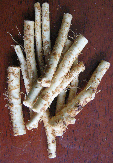
 Horseradish
UT
Horseradish
UTAmoracia rusticana Not to Norfolk Island, NT, TAS or WA Horseradish is a perennial in the Brassica family and has been in use for centuries for its hot, spicy roots. It is a close relative of Wasabi and commonly used as a substitute for the more expensive Wasabi. The large parsnip-sized roots are dug in winter, once the tops die back. The root needs to be grated fresh and used as flavouring and to make sauce, as it doesn't store well. It is suited to temperate and subtropical areas. It can become weedy if disturbed as new plants will grow from the broken roots. More info on growing horseradish Provided as root cuttings. GH100 GH101 |
|
|
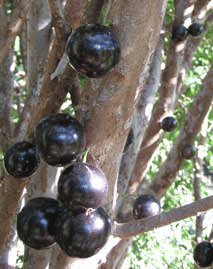 Jaboticaba
UT
Jaboticaba
UTMyrciaria cauliflora Not to Norfolk Island, NT, SA, TAS or WA An excellent ornamental shrubby tree with coppery pink new foliage suitable for a wide climate range from warm temperate to tropical areas. It tolerates light frost and is drought tolerant, although drought will impact fruiting. The fruit is similar to a large black grape and as the fruit is hidden on the internal branches there are usually few bird problems. It is also resistant to fruit fly. Jaboticabas may crop several times a year, depending on water availability and can be pruned hard to keep as a shrub. It is useful as a fruiting hedge and the fruit may be eaten fresh, made into a delicious jam, wine or liqueur. Provided as tubestock. GJ116 GJ117Save $1.90 |
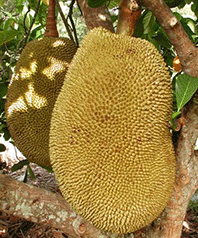 Jackfruit
UT
Jackfruit
UTArtocarpus heterophyllus Not to Norfolk Island, NT, SA, TAS or WA Syn. jakfruit, arbol del pan, jaquiero, kathal. Jackfruit are highly productive, attractive, evergreen large trees to 10 metres plus suited to tropical and subtropical areas. Trees can be kept to a home garden size with appropriate pruning. The fruit is eaten as a vegetable when picked young, at around 1 kg in size. When fully ripe the delicious fruit can be used in ice cream, desserts, smoothies or dried. The protein-rich seeds can be boiled, peeled and roasted. Jackfruit is self-pollinated by wind and insects but fruit set and fruit quality are improved by cross pollination. Grow it in full sun in a fertile well-drained soil pH 6.6 to 7.3. Space the trees 6 to 12 m apart. Grown from seed. Provided in mini pots. GJ101 GJ102Save $1.90 |
 Japanese Raisin Tree
UT
Japanese Raisin Tree
UTHovenia dulcis Not to Norfolk Island, NT, SA, TAS or WA Japanese Raisin Tree syn. Chinese Raisin Tree is an ornamental shade tree well-suited to the home garden and school playgrounds. It grows well with little care and attention. A deciduous tree, it grows to a height of 6 - 9 m with a spread of 4 m. It is suited to temperate and subtropical climates and is very hardy to cold. It produces copious quantities of sweet, raisin-like, edible fruit. It is tolerant of wide range of soil types but prefers good drainage. Space trees 4 m apart in full sun. More info on growing Japanese Raisin Tree... Provided as tubestock. GJ107 GJ110Save $1.90 Available as seed... |
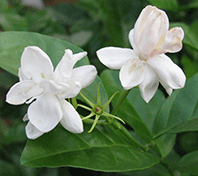 Jasmine Tea
UT
Jasmine Tea
UTJasminum sambac Not to Norfolk Island, NT, SA, TAS or WA Syn. Arabian jasmine, pikake. A very fragrant evergreen climber or rambling shrub which can make an effective groundcover. The leaves are dark green and contrast with the small, white, waxy flowers which appear in clusters. The plant blooms in summer. It has been cultivated for many centuries throughout India, China and south east Asia as both a medicinal and culinary plant. The flower buds are harvested for teas, perfumes and oils. It prefers warmer climates but will grow in most areas of Australia. Provided as tubestock. GJ108 GJ109Save $1.90 |
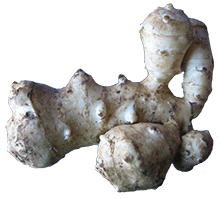
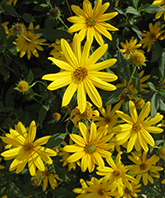 Jerusalem Artichokes
UT
Jerusalem Artichokes
UTHelianthus tuberosus Not to Norfolk Island, NT, TAS or WA Syn. sunchoke, topinambour. A very hardy, easy to grow tuber that can be cooked like potatoes, it does best in well-drained soils. it is especially good for diabetics as it contains no starch. An added bonus is the attractive yellow daisy flowers.Suitable for temperate, subtropical and tropical areas. More info on growing Jerusalem artichokes... Provided as 3 tubers per pack. GJ100min. 3 tubers (1 pack) GJ104min. 9 tubers (3 packs) |
 Kangkong
UT
Kangkong
UTIpomoea aquatica Not to Norfolk Island, NT, SA, TAS or WA Syn. water spinach. Ground-hugging, Thai vegetable that likes moist soil; young leaves, stems and tips are delicious cooked in a stir-fry or steamed. Sow spring and summer. Suitable for subtropical and tropical areas. Provided in mini pots. GK101 GK103Save $1.90 Are you looking for Kangkong seed? |
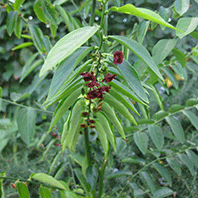 Katuk Sweetleaf
Katuk Sweetleaf
 UT
UTSauropus androgynous Not to Norfolk Island, NT, SA, TAS or WA Katuk Sweetleaf is a perennial, shrubby plant with small red flowers and purple fruit. It can grow to 2 metres tall. A popular vegetable in Asia it is often grown as a hedge around rice paddies. The tender leaves have a pea-like flavour and are 49% protein. Young leaves can be eaten raw in salads; older leaves, small flowers and pea-size fruits are steamed. Add to stir-fry, egg and rice dishes, soups or casseroles. It is suitable for subtropical (frost-free) and tropical areas only and enjoys partial shade to full sun. Provided as tubestock. GK105 GK106Save $1.90 |
 Kencur
UT
Kencur
UTKaempferia galangal Not to Norfolk Island, NT, SA, TAS or WA Syn. cekur, aromatic ginger, sand ginger, cutcherry, resurrection lily, sha jiang. Kencur is a rare, tropical, low growing perennial in the ginger family with very pretty, white and purple flowers produced at ground level. It has tuberous roots and rounded green spreading leaves. It is native to India and widely cultivated in China, Malaysia, Thailand and Indonesia. The fresh rhizomes and young shoots are pickled, eaten raw or cooked as vegetables. The roots are pounded to make an essential ingredient of Indonesian satay sauce. In Malaysian cooking the roots and leaves are used in curry paste for fish and the young leaves are eaten raw as a vegetable. It grows well in the tropics and subtropics; in temperate areas it would need to be grown in a glasshouse. It prefers a shady spot in a protected position and requires moist, well-drained soil, rich in organic matter. Provided as a rhizome per pack. GK113 Provided in mini pots. GK110 GK111Save $1.90 |
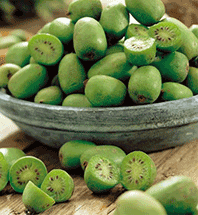 Kiwiberry 'Issai'
UT
Kiwiberry 'Issai'
UTActinidia arguta 'Issai' Not to Norfolk Island, NT, SA, TAS or WA Syn. hardy kiwifruit. Kiwiberry 'Issai' is a very hardy, fast-growing, self-fertile fruiting vine. The green fruit is smooth, hairless and grape-sized; it is a close relative of kiwifruit with the same delicious flavour but usually sweeter. It is a good choice for urban backyards as it takes up far less space and doesn't require a second vine for pollination. That being said, most self-fertile fruits still crop better with a companion nearby. It is a very hardy plant that is frost tolerant and disease resistant. It prefers a position in full sun but will tolerate partial shade with protection from strong winds. The soil should be well-drained, fertile with a pH of 5.5 - 7.0. It requires a strong trellis or fence to grow on. Provided in mini pots. GK120 GK121Save $1.90 |
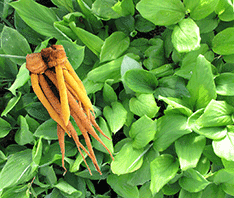 Krachai / Chinese Keys
UT
Krachai / Chinese Keys
UTBoesenbergia rotunda formerly P. pandurata Not to Norfolk Island, NT, SA, TAS or WA Syn. Chinese keys, kachai, kunci. Krachai belongs to the ginger family and is widely cultivated in Indonesia and Thailand for the aromatic, spicy flavour of its rhizome. It is used raw in salads, added to soups and curries especially those made with seafood. It dies back in winter and will reshoot in spring, growing to about 60 - 90 cm in height. Krachai requires a rich moist soil and partial shade. Suitable for subtropical and temperate areas. More info on growing krachai syn. Chinese Keys Provided as tubestock. GK102 GK107Save $1.90 |
 Lebanese Cress
UT
Lebanese Cress
UTAethionema cordifolium Not to Norfolk Island, NT, SA, TAS or WA Syn. stonecress. Lebanese Cress is a low growing to 25 cm high, spreading, perennial herb which is very easy to grow. It likes moist conditions and partial shade. It makes an attractive ground cover with fern-like leaves but be aware it can cover quite a large area so don't plant it where it will become a problem. If space is limited grow it in a pot or saucer. It is a good addition to salads, can be used as a garnish or in soups. Provided in mini pots. GL114 GL119Save $1.90 |
 Leek - Perennial
UT
Leek - Perennial
UTAllium ampeloprasum var. porrum Not to Norfolk Island, NT, SA, TAS or WA Syn. multiplier leeks, perpetual leeks. Rare and hard to find but a garden jewel when you do. These grow just like normal leeks except each plant regularly produces young plants (offsets) around the base. Once these are transplanted they will grow to a full size leek or they can be harvested and used like spring onions. Leeks prefer a cool, rich soil but are also extremely hardy and pest resistant. They grow in full sun to part shade. A delicious vegetable to use in soups, stews, quiches and baked alone. The white shaft plus 10 - 15 cm of the green leaves are eaten. More info on growing Perennial Leeks... Provided as rootsets. GL113 |
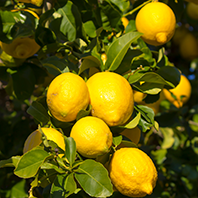 Lemon 'Eureka'
UT
Lemon 'Eureka'
UTCitrus limon Not to Norfolk Island, NT, SA, TAS or WA 'Eureka' is a great lemon tree for warmer areas as it crops almost year-round. The fruit is virtually seedless, large, smooth, with a thin skin and a true lemon flavour. The trees are almost thornless, tall with an open branching habit, dark-green leaves and sweet-smelling white blossoms. Trees are self-pollinated and suit backyards and orchards. It grows best in full sun and a fertile, well-drained soil with winter temperatures above 5°C. Provided as tubestock. GC105 GC107Save $1.90 |
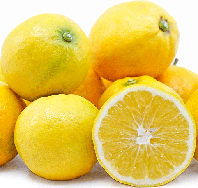 Lemonade
UT
Lemonade
UTCitrus limon x reticulata Not to Norfolk Island, NT, SA, TAS or WA 'Lemonade' trees are highly productive, often producing several crops a year of tangy fruit. The fruit looks just like a lemon and was first discovered growing as a seedling in New Zealand in the late 20th century. Lemonade fruits have a low acidity, are easy to peel with a sweet, citrus flesh that can be eaten fresh. It is the sweetest of lemons and can be juiced for a refreshing drink. The tree grows to 4 m high and benefits from tip pruning. It is self-pollinating and thorny like most citrus. It suits backyards and orchards. Provided as tubestock. GC221 GC222Save $1.90 |
 Lemon Balm
Lemon Balm
 UT
UTMelissa officinalis Not to Norfolk Island, NT, SA, TAS or WA Lemon balm is an herbaceous perennial with a delicate lemon scent. It is a non-running member of the mint family. The leaves are shiny with scalloped edges; small white flowers appear in late spring through midsummer. It attracts bees and butterflies. The fresh or dried leaves are made into a calming herb tea that is used to treat stress, indigestion and headaches. Plant in a cool, semi-shaded position. Suitable for temperate and subtropical areas; unlikely to do well in the tropics. Provided in mini pots. GL112 GL120Save $1.90 Available as seed... |
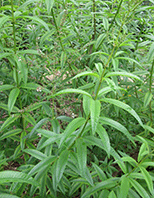 Lemon Verbena
UT
Lemon Verbena
UTAloysia citrodora syn. Aloysia triphylla Not to Norfolk Island, NT, SA, TAS or WA Syn. lemon beebrush, lemon scented verbena. Lemon Verbena is a deciduous, perennial shrub to 2 m high which will grow in most areas of Australia. The small white flowers and leaves have a delightful lemon fragrance. The leaves can be used fresh or dried in desserts, salad dressings, marinades or for herbal tea. The dried leaves can be used for pot pourri. It has a slightly sprawling habit and should regularly be tip pruned to improve its shape. Plant it in a warm, sheltered position in a well-drained, fertile soil. Provided as tubestock. GL136 GL137Save $1.90 |
 Lemongrass 'East Indian'
H
UT
Lemongrass 'East Indian'
H
UTCymbopogon flexuosus Not to Norfolk Island, NT, SA, TAS or WA Less commonly grown lemongrass; it is a taller, to 1.5 m, a more vigorous plant with deep purple stem bases. It produces an attractive purplish seedhead in most areas. Used mainly for herb tea and mulch production. It is resistant to the rust that plagues West Indian Lemongrass. Suitable for warm temperate to tropical areas. More info on growing East Indian Lemongrass... Provided as tubestock. GL116 GL121Save $1.90 |
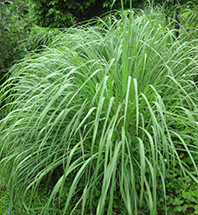 Lemongrass 'West Indian'
H
UT
Lemongrass 'West Indian'
H
UTCymbopogon citratus Not to Norfolk Island, NT, SA, TAS or WA Syn. ta krai, tanglad, serai, sereh, remon gurasu, xiang mao cao, zabalin, sloeuk krey, xa. This is the commonly grown lemongrass in Australia; the thickened stem bases are used in Thai cooking; it is a good source of Vit. A. It grows as a grass-like clumps to 1 m. Suitable for warm temperate to tropical areas. More info on growing West Indian Lemongrass... Provided as tubestock. GL115 GL122Save $1.90 |
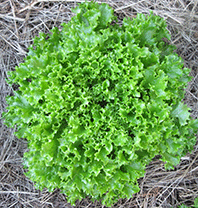 Lettuce 'Darwin'
H
UT
Lettuce 'Darwin'
H
UTLactuca sativa Not to Norfolk Island, NT, SA, TAS, VIC or WA 'Darwin' lettuce is the most useful lettuce we grow. It is a compact, light-green, oakleaf type lettuce that is particularly suited to hot areas. It is slow to bolt, hardy and heat resistant. Loose leaf lettuces are useful to 'cut and come again', as you can just pick leaves as required. Keep the plants mulched so the leaves stay clean. If allowed to flower and the seeds are spread around the garden it will readily self-sow and you may never need to sow lettuce again. Available as seed... |
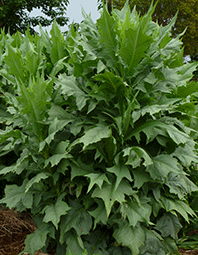 Lettuce 'Timor'
H
UT
Lettuce 'Timor'
H
UTLactuca indica Not to Norfolk Island, NT, SA, TAS or WA syn. Indian Lettuce Indian Lettuce is a close relative of lettuce but grows faster, taller and is hardier to hot temperatures and high humidity. It will grow across a wide climate range from cooler areas to the tropics. It is a fast-growing, upright leafy green that can grow as high as 2 m. It has a semi-perennial habit and can be cut back after flowering to re-shoot. It will grow in full sun, but plants grown in partial shade will produce larger, more tender leaves. Very young, tender leaves are eaten raw in salads, older leaves can be cooked like spinach. The leaves have a somewhat bitter flavour, closer to chicory than lettuce. It is also used in traditional medicine. It self-sows readily and care should be taken to avoid weediness. A useful plant for poultry forage systems. In temperate areas sow late spring; in subtropical and tropical areas sow all year. Seed germinate best between 20 - 26°C soil temperature. Seed takes 4 - 10 days to germinate. Provided in mini pots. GT100 GT102Save $1.90 Available as seed... |
 Licorice
UT
Licorice
UTGlycyrrhiza glabra Not to Norfolk Island, NT, SA, TAS or WA Syn. liquorice. Licorice is a perennial legume to 1.5 m tall that spreads by underground stolons; it dies back in winter. The mauve, pea-like flower spikes appear mid-summer. It prefers a well-drained soil in full sun. Licorice contains glycyrrhizin, which is 50 times sweeter than sugar. The dried roots, which are very hard and fibrous, taste sweet with a slightly bitter aftertaste. The root is used in confectionery and to sweeten medicines. Provided as tubestock. GL125 GL126Save $1.90 Available as seed... |
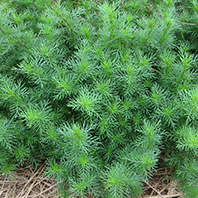 Licorice Herb
UT
Licorice Herb
UTTagetes filifolia Not to Norfolk Island, NT, SA, TAS or WA Syn. hierbe de anise, Irish lace. A leafy annual herb with the strong aroma and intense flavour of licorice in the leaves. It grows as a low mound to 30 cm high with a spread of 30 cm. This is a different plant to the licorice root that is used in confectionery. Licorice Herb likes to grow in full sun and be regularly watered. It produces small white flowers in Autumn and readily self-sows. The sweet fresh leaves can be used in herb teas or cold drinks. Provided in mini pots. GL117 GL118Save $1.90 |
|
Green Harvest specialises in plants which are:
|
Not to NORFOLK ISLAND, NT, SA, TAS or WA
SORRY but due to quarantine restrictions between Australian States no plants at all can be ordered by residents of Norfolk Island, Tasmania and Western Australia. These restrictions are very important as they prevent the spread of plant pests and diseases. No potatoes, garlic, shallots, strawberries or tubestock can be sent to South Australia. No tubestock can be sent to Northern Territory.
SORRY but due to quarantine restrictions between Australian States no plants at all can be ordered by residents of Norfolk Island, Tasmania and Western Australia. These restrictions are very important as they prevent the spread of plant pests and diseases. No potatoes, garlic, shallots, strawberries or tubestock can be sent to South Australia. No tubestock can be sent to Northern Territory.
 Home
Home
Green Harvest Organic Gardening Supplies is permanently closed as of 5pm on 1-11-2023.
We will not be taking orders by this website, in person, by phone or email. Our display garden and retail shop are closed forever.
Read more...
Phone:07 54357000
Phone calls will only be responded to sporadically and only in reference to orders placed prior to 2-11-2023. All the useful growing and organic pest management research and resources are available on this website for a while still.
No liability will be accepted by Green Harvest, its owners or employees as to the accuracy of any information. No responsibility will be taken for damage to property or persons due to information given about a product or technique. No responsibility will be taken for the loss of a crop or income due to information given about a product or technique.
 Shopping here is private and secure.
Shopping here is private and secure.
Copyright © 2001 - 2024 Green Harvest Organic Gardening Supplies
No part of this website may be reproduced without permission of the owner

